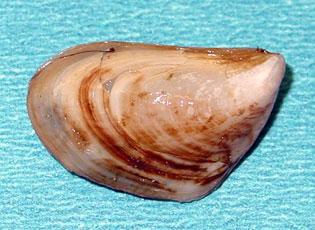Dreissena rostriformis bugensis (Andrusov, 1897); formerly known as Dreissena bugensis (CABI)
Quagga Mussel
Dnieper River drainage of Ukraine (NAS Database)
First discovered in 1989 (NAS Database)
Ballast water (NAS Database)
Alters food web by filtering water and removing plankton; clogs water-intake pipes (NAS Database)

Quagga mussel, adult
Photo by Amy Benson; U.S. Geological Survey
Spotlights
Distribution / Maps / Survey Status
Federally Regulated
All Resources
Selected Resources
The section below contains highly relevant resources for this species, organized by source.
Council or Task Force
Partnership
Federal Government
International Government
State and Local Government
Academic
Professional
CABI. Invasive Species Compendium. Dreissena rostriformis bugensis. CAB International. [Accessed Aug 10, 2023].
Nonindigenous Aquatic Species Database. Fact Sheet - Quagga Mussel. USGS, Gainesville, FL. [Accessed Aug 10, 2023].
